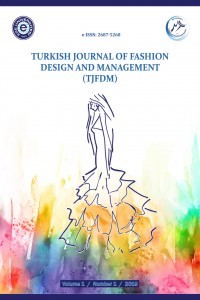Bebek ve Çocuk Giysilerinin Sağlık ve Güvenlik Açısından Değerlendirilmesi
Bebek ve çocuk giysilerinde kullanılan aksesuarlar, fonksiyonel veya süsleme amaçlı kullanılmaktadır. Ancak bu aksesuarların kullanımı, bebek ve çocukların güvenliği açısından çeşitli tehlikelere yol açmaktadır. Ülkemiz dahil birçok ülke, çocuk giysilerinin güvenliği ile ilgili çeşitli standartlar yayınlanmıştır. Bu standartlar, çocuk hazır giyim üreticilerini daha güvenliürün üretmeye teşvik etmektedir. Fakat bu standarların ya da bu konudaki düzenlemelerin bir yaptırım zorunluluğu yoktur. Ancak ürün üretilen firmalar bu konuda yaptırım uygulayabilmektedir. Bu ise, bu konuya çok fazla özen gösterilmemesine neden olmaktadır. Bu çalışmasında, piyasada çocuk hazır giyimi üreten firmaların bir sezonda ortaya koyduğu koleksiyona ait ürünler, internet üzerinden incelenmiş ve hatalı olduğu görülen ürünlerin mağazada fotoğrafları çekilerek hataları değerlendirilmiştir.
Anahtar Kelimeler:
Çocuk giyimi, Sağlık ve güvenlik, Aksesuarlar, Giysi güvenliği
Evaluation of Baby and Child Clothes in terms of Health and Safety
Accessories used in baby and child clothes are used for functional or ornamentation purposes. However, the use of these accessories poses several dangers for the safety of babies and children. Many countries, including our country, have published various standards on the safety of children's clothing. These standards encourage children's garment manufacturers to produce safer products. However, there is no sanction for these standards or regulations on this issue. However, customers can apply sanctions on this matter. This causes not to pay much attention to the issue of garment safety. In this study, the products belonging to the collection produced by the companies producing baby and children clothes in the market, were examined through the internet and the products that seemed to be unsafe were photographed and evaluated.
Keywords:
Children's clothing, Health and safety, Accessories, Clothing safety,
___
- 1. Aktuğlu Öndoğan Z., Ünal Bahadır Z., 2001, “Çocuk Giyiminin Önemi”, Tekstil ve Konfeksiyon Dergisi, Ege Üniversitesi Tekstil ve Konfeksiyon Araştırma-Uygulama Merkezi Yayını, Yıl. 11, Sayı. 4 S. 225-228. 2. Bahadır Ünal Z., Aktuğlu Öndoğan Z., 2009, ‘‘Bebek Giyimleri: Genel Bir Bakış’’, e-Journal of New World Sciences Academy, 4(1), s 24-33. 3. Birleşmiş Milletler Çocuk Hakları Sözleşmesi (OHCHR), 1. Madde, 1995. 4. Children’s Apparel & Accessories Product Safety Guidelines, 2015, National Retail Association, 76p. (https://www.nra.net.au/app/uploads/2015/06/Product-Safety-Childrens-Apparel-Accessories-Product-Safety-Guidelines.pdf) 5. Çivitci Şule, 2004, “Moda Pazarlama”, Asil Yayınları, Ankara. 6. Eicher JB., Sumberg B., 1995, “World Fashion, Ethnic and National Dress”. In J. B. Eicher (Ed.). Dress and ethnicity: Change across space and time, 139-164. 7. Forsberg K., Mansdorf SZ., 2007, “Quick Selection Guide to Chemical Protective Clothing”, 5th ed., New Jersey: John Wiley & Sons. 8.Hayhoe CR., Chungwen H., 2009, “Planning for Baby-Clothing Fabric Choices, Care labels, Comfort, Fit, Size and Safety”, Virginia: Virginia Cooperative Extension. 9. Lindemann A., 2017, Safety Rules for Children’s Clothes (https://howtoadult.com/safety-rules-childrens-clothes-5501.html) 10. Mohrman J., 2010, Safety Issues in Children's Clothing 11. Safe to wear, Inditex, (https://www.inditex.com/documents/10279/241148/Safety+Product+Policy_Inditex/e5ddb37f-ca6e-42e5-1d70-579bd87913b4) 12. Tezel Z., 2012.," Çocuk Dış Giysilerinde Güvenlik Riskleri ve Standartları" e - Journal of New World Sciences Academy, Vol.7, No.3.
- Yayın Aralığı: Yılda 3 Sayı
- Başlangıç: 2019
- Yayıncı: Ege Üniversitesi
